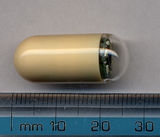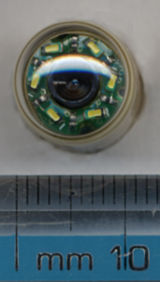Capsule endoscopy


Capsule Endoscopy is a term used to describe a miniature capsule used to record images through the digestive tract for use in medicine. It was developed by an Israeli missile specialist in the mid-1990's. The capsule, also known as a capsule camera or video pill, is a camera with the size and shape of a pill used to visualize the gastrointestinal tract. Capsule endoscopy has other names such as Wireless capsule endoscopy, Miniature Ingestible Capsule, and is marketed as EndoCapsule by Olympus Corp. and PillCam by Given Imaging Ltd. The procedure was approved of by the U.S. Food and Drug Administration in 2001.[1] It is an imaging device for the detection of gastrointestinal diseases.
Uses
Capsule endoscopy is used as a less-invasive procedure in placement of a traditional endoscope, which is a long, thin tube inserted into the rectum and transversed through the colon or into the oral cavity. The technology is used by gastroenterologists to detect diseases such as Crohn's disease, gastric ulcers, and colon cancer. At the present time, the capsule camera is primarily used to visualize the small intestine. Whereas the upper gastrointestinal tract (esophagus, stomach, and duodenum) and the colon (large intestine) can be very adequately visualized with scopes (cameras placed at the ends of thin flexible tubes), the small intestine is very long (average 20-25 feet) and very convoluted. No available scope is able to traverse the entire length of the small intestine. Because the capsule is swallowed and travels through the digestive system, capsule endoscopy takes a longer amount of time than traditional endoscopy. The images are of good quality, comparable to those from scopes. The test carries a high sensitivity and specificity for detecting lesions. Early research has shown that capsule endoscopy can detect evidence of disease in some cases that traditional endoscopy cannot.[2][3]
Recent developments
Much research is occurring in the United States, Israel, Japan, South Korea, and United Kingdom to improve capsule endoscope technology. Sayaka Capsule by RF System of Japan is an advanced capsule with power supplied wirelessly from an external source.[4] In Japan, capsule endoscopy is now approved for use in the small bowel and in Europe, capsule endoscopy is being used for several areas including colon screening since July, 2007. The next major development is to enable the capsule to do other functions that are possible with current traditional endoscopes, besides just imaging with a camera. These include multiple therapeutic and diagnostic operations such as ultrasound, electrocautery, biopsy, laser, and heat with a retractable arm.[5]
Footnotes
- ↑ "Capsule Endoscopy in Gastroenterology". Mayo Clinic. Accessed October 5 2007.
- ↑ Herrerías, J.M., et al. "Capsule Endoscopy in Patients with Suspected Crohn’s Disease and Negative Endoscopy". Endoscopy. European Society of Gastronintestinal Endoscopy. 2003; 35: 564-568 DOI: 10.1055/s-2003-40241.
- ↑ Mylonaki, M., et al. "Wireless capsule endoscopy: a comparison with push enteroscopy in patients with gastroscopy and colonoscopy negative gastrointestinal bleeding". Gut, August 2003; 52: 1122 - 1126.
- ↑ Pink Tentacle. "Sayaka: Next-generation capsule endoscope". January 1 2005.
- ↑ "Miniature Ingestible Capsule patent". Free Patents Online. United States Patent 20060195015, Kind Code A1.
References
- Sidhu, Reena, et al. "Gastrointestinal capsule endoscopy: from tertiary centres to primary care". BMJ, March 4 2006. 332:528-531. doi:10.1136/bmj.332.7540.528.